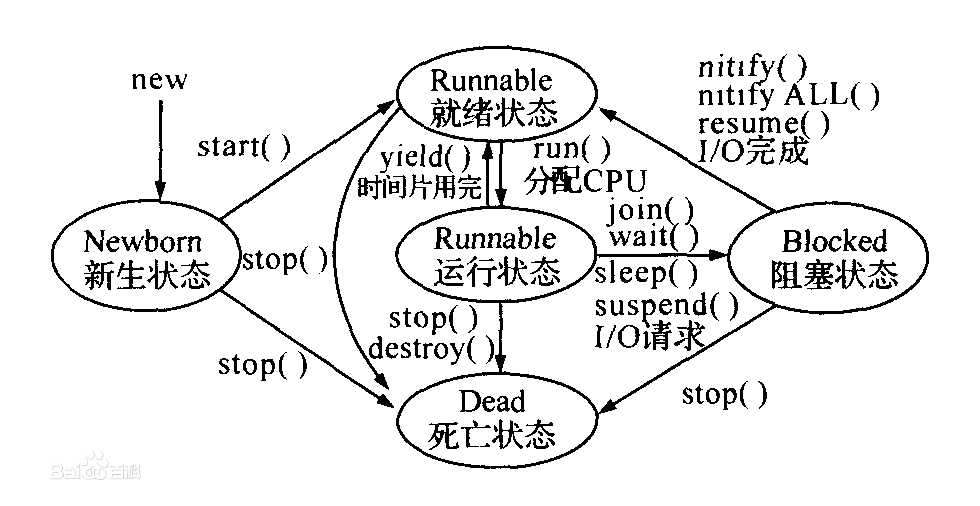标签:
在多线程环境下,每个线程拥有一个栈和一个程序计数器。栈和程序计数器用来保存线程的执行历史和线程的执行状态,是线程私有的资源。其他的资源(比如堆、地址空间、全局变量)是由同一个进程内的多个线程共享。
http://www.cnblogs.com/Rosanna/p/3581835.html
一.概念题
1.线程的基本概念、线程的基本状态及状态之间的关系?
线程是进程中某个单一顺序的控制流,是程序执行流的最小单位。线程由线程ID、当前指令指针、寄存器集合和堆栈组成。线程是进程的一个实体,是被系统调度和分配的基本单位,线程与同一进程中的其他线程共享进程的全部资源。
线程有五种基本状态:新生状态,就绪状态,运行状态,阻塞状态,死亡状态。状态间关系如下图:

2.线程与进程的区别?
(1)进程是系统资源分配和调度的独立单位;线程是进程的一个实体,是CPU调度和分派的基本单位。
(2)系统资源分配给进程;线程与资源分配无关,线程与同一进程内的其他线程共享进程的全部资源。
(3)不同的进程拥有不同的虚拟地址;同一进程下的不同线程共享同一地址空间。
3.在Windows编程中互斥量与临界区比较类似,请分析一下二者的主要区别。
(1)临界区不是内核对象,只能用于进程内的线程间同步,速度快;
(2)互斥量是内核对象,可以用于进程间同步,在核心态进行锁操作,速度慢;
(3)Linux中只有互斥量,用来保护临界区,保证同一时间只由一个线程访问临界区的共享资源。
4.多线程同步和互斥有何异同?多线程同步和互斥有几种实现方法?在什么情况下分别使用他们?
同步指线程间的一种制约关系,一个线程的执行依赖于另一个线程的消息,消息未到达就等待,到达就被唤醒;
互斥指对于一个进程的共享资源,任何时候只有一个线程可以访问,其他要访问的线程必须等待,直到该线程释放资源;
实现方法分为用户模式和内核模式。用户模式:临界区;内核模式:互斥量,信号量,事件。
(信号量允许多个线程同时使用共享资源,规定了同时访问共享资源的线程最大数目。
事件可以实现不同进程中的线程同步操作,并且可以方便的实现多个线程的优先比较等待操作。)
二.选择题
1.以下多线程对int型变量x的操作,哪几个不需要进行同步:
A. x=y; B. x++; C. ++x; D. x=1;
2.多线程中栈与堆是公有的还是私有的
A:栈公有,堆私有
B:栈公有,堆公有
C:栈私有,堆公有
D:栈私有,堆私有
三.编程题
1.子线程循环 10 次,接着主线程循环 100 次,接着又回到子线程循环 10 次,接着再回到主线程又循环 100次,如此循环50次,试写出代码。
#include<stdio.h>
#include<stdlib.h>
#include<errno.h>
#include<pthread.h>
#include<unistd.h>
int num=1; //全局变量
static pthread_mutex_t mutex=PTHREAD_MUTEX_INITIALIZER;
static pthread_cond_t cond=PTHREAD_COND_INITIALIZER;
void *func();
int main()
{
pthread_t tid;
int ret=0,i,j;
if((ret=pthread_create(&tid,NULL,func,NULL))!=0)
printf("create thread error!\n");
for(i=0;i<3;i++)
{
pthread_mutex_lock(&mutex);
if(num!=0)
pthread_cond_wait(&cond,&mutex);
num=1;
for(j=0;j<10;j++)
{
printf("0");
}
printf("\n");
pthread_mutex_unlock(&mutex);
pthread_cond_signal(&cond);
}
return 0;
}
void *func()
{
int i,j;
for(i=0;i<3;i++)
{
pthread_mutex_lock(&mutex);
if(num!=1)
pthread_cond_wait(&cond,&mutex);
num=0;
for(j=0;j<5;j++)
{
printf("1");
}
printf("\n");
pthread_mutex_unlock(&mutex);
pthread_cond_signal(&cond);
}
pthread_exit(0);
}
2.编写一个程序,开启3个线程,这3个线程的ID分别为A、B、C,每个线程将自己的ID在屏幕上打印10遍,要求输出结果必须按ABC的顺序显示;如:ABCABC….依次递推。
#include<stdio.h>
#include<stdlib.h>
#include<error.h>
#include<unistd.h>
#include<pthread.h>
int num=0;
static pthread_mutex_t mutex=PTHREAD_MUTEX_INITIALIZER;
static pthread_cond_t cond=PTHREAD_COND_INITIALIZER;
void *func(void *);
int main()
{
pthread_t tid[3];
int ret=0,i;
for(i=0;i<3;i++)
if((ret=pthread_create(&tid[i],NULL,func,(void*)i))!=0)
printf("create thread_%c error\n",i+‘A‘);
for(i=0;i<3;i++)
pthread_join(tid[i],NULL);
printf("\n");
return 0;
}
void *func(void *argc)
{
int i;
for(i=0;i<10;i++)
{
pthread_mutex_lock(&mutex);
while(num!=(int)argc)
pthread_cond_wait(&cond,&mutex);
printf("%c",num+‘A‘);
num=(num+1)%3;
pthread_mutex_unlock(&mutex);
pthread_cond_broadcast(&cond);
}
pthread_exit(0);
}
3. 有一int型全局变量g_Flag初始值为0;
在主线称中起动线程1,打印“this is thread1”,并将g_Flag设置为1
在主线称中启动线程2,打印“this is thread2”,并将g_Flag设置为2
线程序1需要在线程2退出后才能退出
主线程在检测到g_Flag从1变为2,或者从2变为1的时候退出
#include<stdio.h>
#include<stdlib.h>
#include<error.h>
#include<pthread.h>
#include<unistd.h>
int flag=0;
void *thread1(void*);
void *thread2(void*);
static pthread_mutex_t mutex=PTHREAD_MUTEX_INITIALIZER;
static pthread_cond_t cond=PTHREAD_COND_INITIALIZER;
int main()
{
printf("enter main\n");
pthread_t tid1,tid2;
int ret=0;
if((ret=pthread_create(&tid1,NULL,thread1,&tid2))!=0)
printf("create thread1 error!\n");
if((ret=pthread_create(&tid2,NULL,thread2,NULL))!=0)
printf("create thread2 error!\n");
pthread_cond_wait(&cond,&mutex);
printf("leave main\n");
return 0;
}
void *thread1(void *argc)
{
printf("this is thread1\n");
pthread_mutex_lock(&mutex);
if(flag==2)
pthread_cond_signal(&cond);
flag=1;
pthread_mutex_unlock(&mutex);
pthread_join(*(pthread_t*)argc,NULL);
pthread_exit(0);
}
void *thread2(void *argc)
{
printf("this is thread2\n");
pthread_mutex_lock(&mutex);
if(flag==1)
pthread_cond_signal(&cond);
flag=2;
pthread_mutex_unlock(&mutex);
pthread_exit(0);
}
题目摘自:
1.http://blog.csdn.net/morewindows/article/details/7392749
2.http://www.cnblogs.com/skynet/archive/2010/10/30/1865267.html
标签:
原文地址:http://www.cnblogs.com/guxuanqing/p/5882990.html